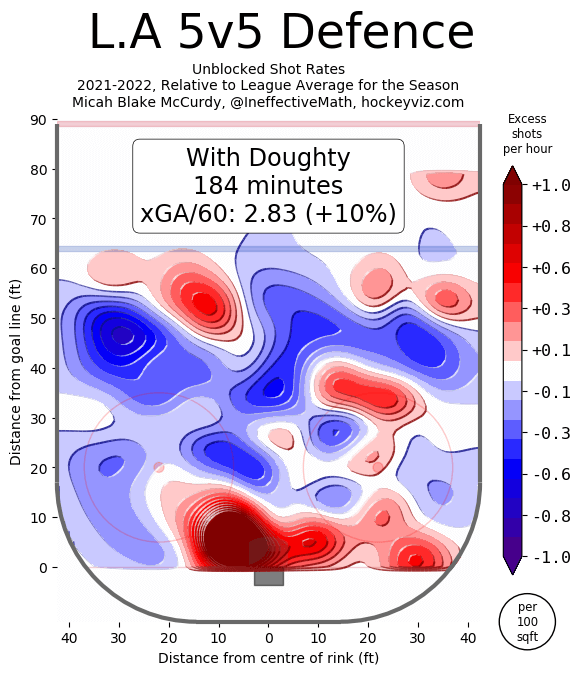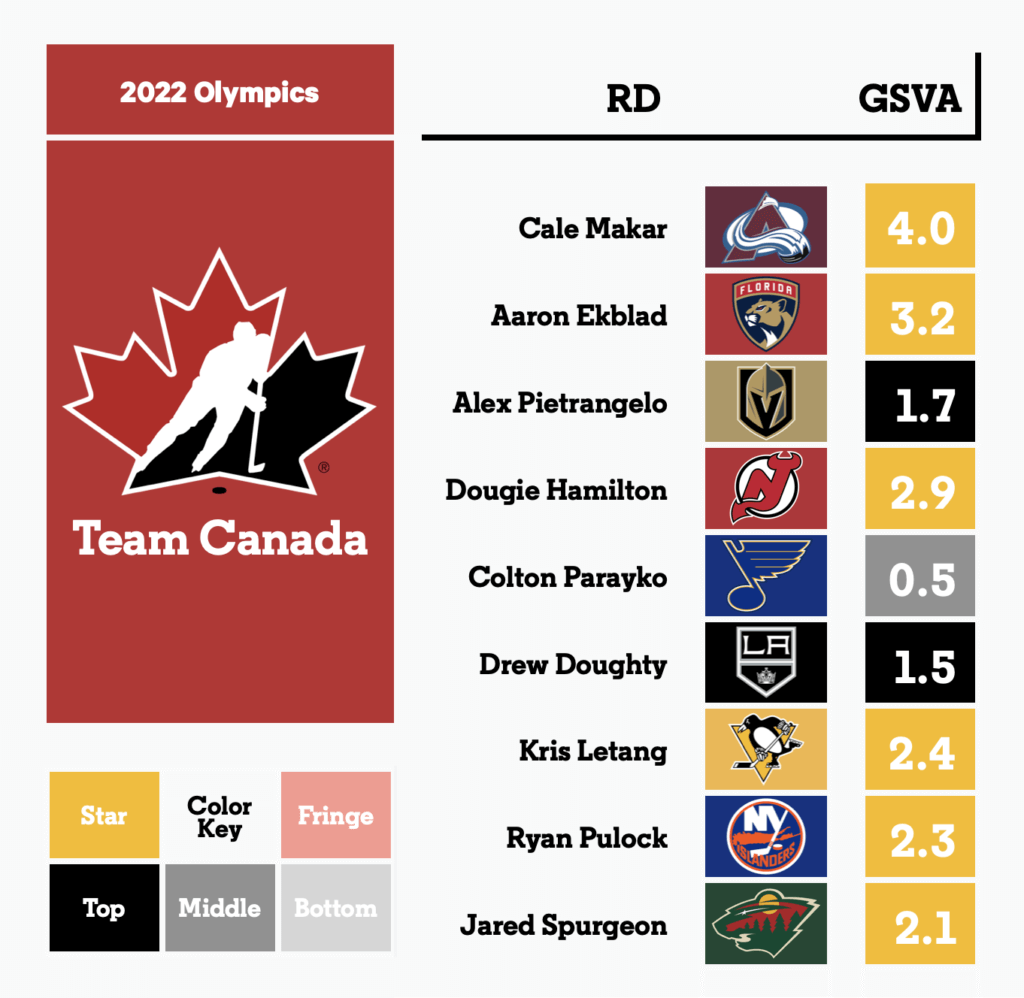Until there’s a final decision on the NHL’s participation in the Olympics, or players publicly voice their decisions on whether or not to attend, there’s going to be speculation on which players will be asked to play for their countries.
Much of the focus will rightfully be on the powerhouse that is Team Canada. The only area that’s truly in question is in goal — which puts an emphasis on the blue line designed in front. So far, one defender was already named in the initial roster, Alex Pietrangelo. But there are quite a few options to surround the Golden Knights’ defender, if he chooses to go.
Advertisement
As the season’s progressed, player trends on the ice have influenced their chances of making the Olympic roster. And as The Athletic’s Pierre LeBrun and Harman Dayal wrote last week, Dougie Hamilton’s chances appear to be falling.
Should they be, though? Or should Hamilton be a legitimate consideration for Team Canada?
Let’s dive in.
Hamilton’s opened the 2021-22 season with six goals and 15 points in 23 games. When weighing his ice time, that rates out to 1.77 points per 60 which stands as the fourth-best mark of his career but behind each of the last two seasons. So in theory, it’s easy to mark off this year as a step back.
The biggest difference this year for Hamilton is the team around him — both in terms of personnel and systems. The 2020-21 Hurricanes were a legitimate contender, and he spent much of the year alongside one of the best defenders in the league in Jaccob Slavin. Now, he’s with a rebuilding Devils’ team that has some flaws at both ends of the ice.
Still, at 5-on-5, he’s making a positive impact.
Hamilton generally ranks highly among defenders in his puck movement. That’s no different this season, according to Corey Sznajder’s tracking. The right-handed defenseman is able to bring the puck out of his own end with possession, with that transition play often starting with a puck retrieval in the defensive zone. And he’s able to move the puck over the blue line and into the offensive end with control. Those entries often lead to scoring chances for the Devils.
According to HockeyViz, his 5-on-5 isolated offensive impact is still pretty consistent from years past — he helps boost the team’s expected goal generation 12 percent more than the average defender would in his minutes.
Advertisement
 Via HockeyViz
Via HockeyViz
And with him on the ice, New Jersey generates an expected goal rate of 3.15 per 60 which is 23 percent stronger than league average. Without him, to compare, the team’s xG rate is seven percent below league average as they don’t generate a high rate of shots from the home plate area in front of the net.
All the while, as the heat maps above show, he’s generally maintained a positive defensive impact.
What’s affecting his stat-line, which can drive the narrative that he’s not as impactful this season, is the Devils’ struggling power play. Last year, to compare, he had 18 points on the man-advantage to help boost his scoring totals to 42 points in 55 games. This year, he’s only tallied four points there.
The power play is better while Hamilton’s on the ice, but he’s not the only player on in those minutes — seeing as he’s on the top unit, he’s typically on with the team’s best offensive players so it’s not entirely surprising to see more production from that unit than the second. Still, that weakness in New Jersey is limiting his point totals and the team’s overall potential. That’s a team-wide problem that’s been daunting them throughout the season, though.
Hamilton doesn’t have Slavin on his right, or a contending team around him, but he’s still effective with his new club, generally alongside Ryan Graves. So while some of the ‘on ice’ defensive numbers aren’t the same as years past, the context is important given his current surroundings — from his fellow skaters, to the goaltending behind him. With all of that in mind, his level of play this year shouldn’t have such a negative influence on his chances for Team Canada.
But whether Hamilton makes the team isn’t just going to depend on his play, but the others in consideration as well.
Assuming the preference is to rely on lefty-righty combinations on defense, there are quite a few options for both sides. On the left, Morgan Rielly, Shea Theodore, Darnell Nurse, Adam Pelech, Jakob Chychrun, Thomas Chabot, Josh Morrissey, MacKenzie Weegar, and Devon Toews will likely all be in the conversation, with predictably four making the team.
Advertisement
On the right, there’s obviously Pietrangelo leading things off. There’s also Cale Makar, Aaron Ekblad, Colton Parayko, Drew Doughty, Ryan Pulock, Kris Letang, Jared Spurgeon, and of course, Hamilton in contention.
How Team Canada chooses to proceed really depends on what they prioritize. If they feel they want each defender in the ideal position to succeed, maybe that inspires management to look to existing pairs. That could boost the chances of Weegar or Toews to make the team to play alongside mainstay partners Ekblad and Makar who are bound to be on the squad.
But with that line of thinking aside, we can focus on which players should make the team based on actual value and balance of skills.
If all three choose to go — and that’s the big ‘if’ right now — the right side may line up with Pietrangelo, Makar, and Ekblad leaving one more opening for a righty. As LeBrun and Dayal noted, that may come down to Doughty, Parayko, and Hamilton.
Which of the three should actually be leading the race?
Doughty may have the experience, but his level of play doesn’t match what should be expected for the Olympic roster. At 5-on-5, the Kings may be scoring about 61 percent of the goals share, but expectations are closer to 48 percent — and that’s while playing alongside the team’s top forward talent. As The Athletic’s Dom Luszczyszyn noted in 16 Stats last week, Doughty’s numbers, for the most part, since returning to the lineup have been awful.
To Doughty’s credit, he’s asked to take on a tough workload in terms of the competition he sees — but the Kings, while seeing a lower shot rate, are still bleeding chances in the net-front area while he’s deployed.

Via HockeyViz
So if this were the 2018 Olympics, he should have been in the conversation. In 2022, the same can’t be said.
Parayko, like Doughty, also faces tough competition. He doesn’t have that same support from his quality of forward teammates he’s often deployed with, though. While he’s generally made a positive impact in his own zone to help limit quality chances against, he doesn’t thread the needle offensively. This year, the Blues’ expected goal generation for is 16 percent below average while he’s on the ice, versus 11 percent better than average when he’s on the bench.
Advertisement
Hockey Canada may want defenders who can absorb those ‘tough’ minutes as extras, especially if their goaltenders struggle. That’s why they could be inclined to have Parayko or Doughty on the roster. But just because they can play those minutes, doesn’t mean they should at the Olympic level. There are numerous defensemen who can play that shutdown role and thrive — and quite a few of those players could join the team on the left, depending on what combination of Theodore, Pelech, Toews, or Weegar make the team.
The argument, on the other hand, could be that a player like Hamilton — an offensive, power play specialist — may not be necessary with Makar or Rielly. Plus, other defenders on the roster lead a power play, like Pietrangelo, Theodore, Ekblad, or Doughty if he were to make it as well.
But for the Olympics, with some of the best players in the world competing, having extra offensive weapons wouldn’t hurt — even if not deemed a mainstay player in the lineup. At the very least, Hamilton could serve as the extra defender to help give the lineup a spark when needed. That’s what he would provide at a minimum because despite playing on a team that has brought down some of his numbers this season compared to recent years past, he’s still a more valuable defenseman than others in contention for the right side of the blue line.

The only reason Dougie Hamilton doesn’t go to the Olympics — as long as the NHL ultimately sends players — should be if he opts out; not Hockey Canada leaving him off the roster.
Data via Evolving-Hockey, HockeyViz, Corey Sznajder and Dom Luszczyszyn. This story relies on shot-based metrics; here are primers (part 1, part 2) on these numbers.
(Photo: Elsa / Getty Images)
